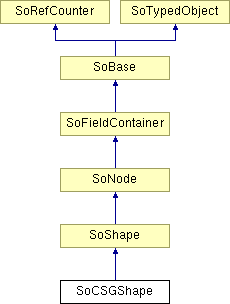SoCSGShape Class Reference
[Shapes]
 Shape defined by a binary boolean operation on two sub scene graphs.
More...
Shape defined by a binary boolean operation on two sub scene graphs.
More...
#include <Inventor/nodes/SoCSGShape.h>

Public Types | |
| enum | CsgOperationType { ADD, SUB, INTERSECTION, LEFT_ONLY, RIGHT_ONLY, NOTHING, ALL } |
| enum | CsgStatus { CSG_NO_ERROR, CSG_LIB_NOT_AVAILABLE, CSG_ERROR } |
Public Member Functions | |
| virtual SoType | getTypeId () const |
| SoCSGShape () | |
| void | setMaxAttempt (int maxAttempt) |
| CsgStatus | getStatus () |
Static Public Member Functions | |
| static SoType | getClassTypeId () |
| static void | setRescueOperation (CsgOperationType op) |
Public Attributes | |
| SoSFNode | leftOperand |
| SoSFNode | rightOperand |
| SoSFEnum | csgOperation |
Detailed Description
 Shape defined by a binary boolean operation on two sub scene graphs.
Shape defined by a binary boolean operation on two sub scene graphs.
This shape represents the result of a Constructive Solid Geometry (CSG) operation applied on the two scene graphs leftOperand and rightOperand. Constructive solid geometry allows the application to create a (potentially) complex object by using Boolean operators to combine (relatively) simple objects.
The left and right operands can be any scene graph, including other SoCSGShape nodes. You can define a complex CSG geometry by creating a tree using multiple SoCSGShape nodes. The specified scene graph's shapes must be closed (no holes) and CCW-orientated (all triangles composing shapes must be counter-clockwise).
Each time an operand is modified, a CSG Operation is performed. Keep this in mind if you create a CSGTree (SoCSGShape which contains other SoCSGShapes), especially if you use associative and commutative operations (only additions or only intersections) because the result of such operations does not depend on the tree ( (A + B) + C = A + (B + C) ). In this case, try to build your tree by putting the most often modified nodes at the top of the tree.
For example, a tree optimized for modification on first node ( N1 ) will look like this:
S
__|__S
| __|__S
N1 | __|__S
N2 | __|__
N3 | |
N4 N5
Where S are SoCSGShape and N1, N2, ... are ordinary nodes. In this case, a modification on N1 will need only 1 csgOperation, whereas a modificaion on N5 will need 4 csgOperations to regenerate the resulting shape.
A tree optimized for random modification will try to minimize its depth:
S
________|_________
| |
____S____ ____S____
| | | |
__S__ N3 N4 N5
| |
N1 N2
In this case, any modification will require at most 3 CSG Operations.
NOTE: node available since Open Inventor 8.6FILE FORMAT/DEFAULT
- CSGShape {
| leftOperand | NULL |
| rightOperand | NULL |
| csgOperation | ADD |
NOTES
- CSG means Constructive Solid Geometry.
- Some operations are not commutative (A - B) != (B - A).
LIMITATIONS Only vertices are handled in the generated shape. None of the normal, color, or texCoord properties of the left or right operands are taken into account. Shaders are also not taken in account, even vertex shaders. But note that you can use a shader above SoCSGShape. The shader will be applied to the result of the CSG operation.
SEE ALSO
- See related examples:
Member Enumeration Documentation
CSG operation to be used.
- Enumerator:
Status of CSG operation.
Status can be queried using the getStatus() method.
Constructor & Destructor Documentation
| SoCSGShape::SoCSGShape | ( | ) |
Constructor.
Member Function Documentation
| static SoType SoCSGShape::getClassTypeId | ( | ) | [static] |
Returns the type identifier for this class.
Reimplemented from SoShape.
| CsgStatus SoCSGShape::getStatus | ( | ) |
Returns status of csg operation.
- Note:
- Status is updated only when the node is traversed. Initially returns CSG_NO_ERROR. Use enum CsgStatus.
| virtual SoType SoCSGShape::getTypeId | ( | ) | const [virtual] |
Returns the type identifier for this specific instance.
Reimplemented from SoShape.
| void SoCSGShape::setMaxAttempt | ( | int | maxAttempt | ) |
If the CSG Operation failed for any reason, it will be retried by applying a small random transformation to the operand vertices.
This can solve the problem if the geometries are well formed, but for example 2 faces are coplanar. This method sets the max number of times SoCSGShape will retry before giving up and using the rescueOperation (see setRescueOperation). A max attempt of 5 is enough. If CSG Operation fails after 5 attempts, it will probably fail all the time.
Default is 5.
- Warning:
- A value > 0 may change the coordinates of geometries as they will be transformed a little bit to apply the CSG operation. This transformation is normally not visible to the naked eye (it's about 0.01%), but may cause issues if you need precise values.
| static void SoCSGShape::setRescueOperation | ( | CsgOperationType | op | ) | [static] |
Set operation to use if the CSG operation fails or CSGLib is not available.
Default is NOTHING. Must be one of LEFT_ONLY, RIGHT_ONLY, NOTHING or ALL. Use enum CsgOperationType.
Member Data Documentation
CSG boolean operation to apply.
Use enum CsgOperationType. Default is ADD.
Geometry scene graph to be used as left operand for the Boolean operation.
Geometry scene graph to be used as right operand for the Boolean operation.
The documentation for this class was generated from the following file:
- Inventor/nodes/SoCSGShape.h